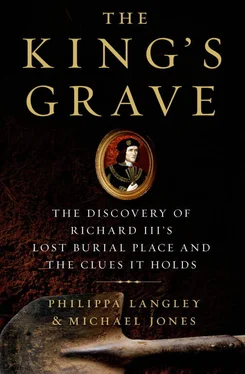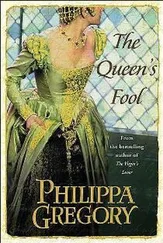Then, in late summer 2007, an archaeological excavation took place in Grey Friars Street in Leicester where a small single-storey 1950s extension at the NatWest/Pares Bank site was being demolished to make way for a block of flats. Undertaking the archaeology was University of Leicester Archaeological Services (ULAS), and what they discovered or, more precisely, what they did not discover, changed my plans irrevocably.
The dig was in the Greyfriars area, but the only find that suggested there might have been a medieval church in the vicinity was a fragment of a stone coffin lid found in a post-medieval drain. The dig was dismissed locally as of little importance, but I disagreed. It suggested that the Greyfriars Church was located further to the west of the Greyfriars area than had been assumed, away from the heavily developed eastern part towards the car parks, open spaces ripe for archaeological investigation.
I wrote to Leicester City Council’s archaeologist, Chris Wardle, requesting further information on the dig, but received no response. However, after I encouraged the Richard III Society to make contact, Wardle was persuaded to write an article for the society’s Ricardian Bulletin, which gave me a much clearer picture of the Greyfriars area.
It had previously been asserted that Richard might have first been buried in the Church of the Annunciation in the Newarke in Leicester, but in 2008 John Ashdown-Hill found more evidence to support the Greyfriars Church burial. And in her book Richard III: The Maligned King, Annette Carson examined sources contemporary with Richard III (i.e. pre-Tudor) with the aim of uncovering the man behind the myth, and proved that it was possible to discover the king’s real character. The Maligned King suggested that the king probably still lay undisturbed where he was originally buried in the Greyfriars Church, which was most likely situated under the private car park of the Department of Social Services. It was the first book I had read to make this claim.
The next piece in the jigsaw once more came from John Ashdown-Hill. While researching Richard’s burial, he discovered that it was John Speed who had started the story about the removal of Richard’s remains, as a means of explaining why he could find no trace of Richard’s grave. But Speed’s map showed that he had been looking for the grave in the wrong place. He had been looking in the Blackfriars (Dominicans) site, not the Greyfriars (Franciscans), and it was the Blackfriars site he had reported as overgrown with nettles and weeds. Ashdown-Hill concluded that the body of Richard III had not been dug up in 1538 and was therefore still at the Greyfriars site.
So the question remained: where was the Greyfriars Church? The street names and the recent dig in Grey Friars Street appeared to confirm my instinct that the burial place was on the northern side of the Social Services car park where I had had my experience. But I needed evidence, without which no one could be expected to take me seriously.
Then, researching in the Richard III Society’s archives, I found a copy of a medieval map from Leicestershire County Council records. This showed the Greyfriars Church opposite St Martin’s Church (now Leicester Cathedral) at what is now the northern end of the Social Services car park. I had my smoking gun (see map).
In February 2009 I invited Ashdown-Hill to Edinburgh to give a series of talks to the Scottish Branch of the Richard III Society about his mtDNA discovery and the history of Richard’s burial place in Leicester. His research into priory churches, particularly mendicant orders reliant upon begging such as the Greyfriars, showed their churches were located alongside major roads. The Greyfriars Church must, he said, be on the northern side of the Social Services car park.
We broke for lunch at the Cramond Inn where I announced my intention to search for King Richard’s grave. I would need the permission of Leicester City Council (LCC), the car park landowners, and would have to commission, and pay for, a Ground Penetrating Radar (GPR) survey that would use radar pulses to locate subsurface anomalies, and the archaeological dig to follow. Dr Raymond Bord, the branch’s treasurer, had a contact in Leicester, while Dr David and Wendy Johnson had details for one of the key Time Team members. I also urged John Ashdown-Hill to write to ULAS, the local archaeological team.
Time Team confirmed their lack of interest, and ULAS didn’t respond. It was a blow, but I was undaunted. As Ashdown-Hill left to take up a university post in Turkey, the recession hit hard. My priority had to be to get LCC behind a search for the grave. I needed some powerful means of persuasion: I needed television.
Philippa Langley’s smoking gun. The Church of the Greyfriars (16) is depicted directly opposite St Martin’s Church (14), now Leicester Cathedral, in what is the northern end of the Social Services car park.
By September 2010, having sounded out the TV industry, I approached Dr Bord’s Leicester contact (retired lawyer Paul Astill) who put me in touch with local councillor Michael Johnson, and through him I contacted Sheila Lock, LCC’s chief executive. I proposed a TV documentary special, Looking for Richard: In Search of a King. UK archaeological units had confirmed that archaeological practice was to reinter as close as possible to the point of discovery, so Leicester Cathedral (situated directly opposite the projected area of exploration) was proposed in the pitch as the place for reburial. Within weeks, Lock had written to confirm LCC’s interest.
I now commissioned the Johnsons, founding members of the project from its inception at the Cramond Inn and who were supporting my search, to design a tomb for Richard. Historian David and his artist wife Wendy had over forty years’ experience in researching Richard III. My own research now widened to include the law on burials and exhumation, the Ministry of Justice (MoJ) policy, and the funeral customs of medieval kings. I would be searching for the mortal remains of an anointed King of England, an unprecedented goal, for which no guidelines existed. I would use desk-based research to underpin what principles I could, together with advice from the relevant authorities.
The law on the exhumation of named individuals with living relatives sets out the decency and privacy with which the exhumation must be carried out. Exhumations of, and archaeological reports on, dead soldiers from the two world wars, for example, carry an important prohibition: archaeologists are not free to publish photographs of the remains unless surviving relatives give their permission. However, there is no law protecting the remains of named individuals dating from more than 100 years ago. The only case that gave any clues as to seemly conduct was the discovery of the remains of Anne Mowbray, Duchess of York and Norfolk, who died in 1481 aged eight. Her coffin had been discovered by workmen clearing the site of a church in east London in 1964 and an archaeologist began an investigation of the remains, but without obtaining any proper consent. After questions in the House of Lords, Mowbray’s relatives closed the investigation, but their action came too late to stop pictures of the remains being published in the newspapers. It was a lesson in what not to do, as I pointed out to the authorities.
The Reburial Document was ready. Drawn up by Dr David and Wendy Johnson, its purpose was to convince potential partners that the Looking for Richard project was serious and viable. Its eleven pages, together with the pitch document, set out the ethos behind the project, which would have two main aims:
• to search for the grave of Richard III, and, if found, honour him with a reburial and tomb;
Читать дальше












